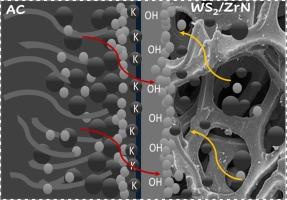Augmenting the electrochemical capability of TMDCs thin film electrodes via interface engineering for energy storage applications
IF 3.9
3区 材料科学
Q2 MATERIALS SCIENCE, MULTIDISCIPLINARY
引用次数: 0
Abstract
Low power density and low energy density associated with traditional devices, such as batteries, and supercapacitors led to the development of hybrid supercapacitors (HSCs). Researchers explore various classes of materials to cope with these limitations. Among them, transition metal dichalcogenides (TMDCs), due to their layered structure, are widely analyzed. Here the sputtering route was adopted to deposit a uniform interfacial layer of zirconium nitride (ZrN) 100 nm, which plays a crucial role in modulating the electrochemical properties of the top sputtered tungsten disulfide (WS2) layer of 250 nm. The electrochemical measurements resulted the specific capacitance of 858F/g for WS2 and 2036F/g for WS2/ZrN at scan rate of 3 mV/s. Hybrid device WS2/ZrN//AC exhibited an energy density of 76 Wh/kg, and a power density of 4325 W/kg. In addition to this, a semiempirical approach is adopted to deconvolute capacitive and diffusive contributions. This hybrid structure can improve charge storage capacity, stability, and cycle life, making it a promising material for next-generation energy storage solutions.

通过界面工程增强 TMDCs 薄膜电极的电化学能力,用于储能应用
与电池和超级电容器等传统设备相关的低功率密度和低能量密度导致了混合超级电容器(HSC)的发展。研究人员探索了各类材料来应对这些限制。其中,过渡金属二卤化物(TMDCs)因其层状结构而被广泛分析。这里采用溅射方法沉积了一层 100 nm 的均匀氮化锆(ZrN)界面层,它在调节顶部溅射的 250 nm 二硫化钨(WS2)层的电化学特性方面起着至关重要的作用。电化学测量结果表明,在扫描速率为 3 mV/s 时,WS2 的比电容为 858F/g,WS2/ZrN 的比电容为 2036F/g。WS2/ZrN//AC 混合器件的能量密度为 76 Wh/kg,功率密度为 4325 W/kg。此外,还采用了一种半经验方法来消除电容性和扩散性贡献。这种混合结构可以提高电荷存储容量、稳定性和循环寿命,使其成为下一代能源存储解决方案的一种有前途的材料。
本文章由计算机程序翻译,如有差异,请以英文原文为准。
求助全文
约1分钟内获得全文
求助全文
来源期刊

Materials Science and Engineering: B
工程技术-材料科学:综合
CiteScore
5.60
自引率
2.80%
发文量
481
审稿时长
3.5 months
期刊介绍:
The journal provides an international medium for the publication of theoretical and experimental studies and reviews related to the electronic, electrochemical, ionic, magnetic, optical, and biosensing properties of solid state materials in bulk, thin film and particulate forms. Papers dealing with synthesis, processing, characterization, structure, physical properties and computational aspects of nano-crystalline, crystalline, amorphous and glassy forms of ceramics, semiconductors, layered insertion compounds, low-dimensional compounds and systems, fast-ion conductors, polymers and dielectrics are viewed as suitable for publication. Articles focused on nano-structured aspects of these advanced solid-state materials will also be considered suitable.
 求助内容:
求助内容: 应助结果提醒方式:
应助结果提醒方式:


